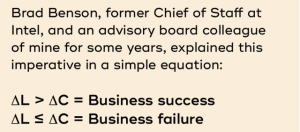Supporting a learning culture: there’s more than meets the eye
“Progress is impossible without change, and those who cannot change their minds cannot change anything.”
George Bernard Shaw (1856-1950)
An article by Charles Jennings.
Organisations need to adapt and evolve; fostering a culture of continuous learning and improvement is paramount for this to happen. When organisations cease to adapt in a changing world, they become irrelevant, or fade and disappear.
There are many examples of world-leading companies that have suffered this fate. The ‘Kodak moment’, and the decline of the once innovative Nokia, which evolved from paper and gumboot manufacture to electronics, are just two examples.

When the rate of learning in an organisation is greater than the rate of external and internal change, the outcome is likely to be success. However, when the rate of learning is less than or equal to the rate of change the result will likely be failure. In other words, learning is at the heart of organisational success or organisational failure.
If we are to foster a culture of continuous learning and improvement, we need to embrace a broader and output-focused view of learning, where learning is not limited to formal education and training (‘schooling’) but is ingrained in the DNA of our organisations, empowering employees to improve their ability to respond to change, to innovate, and deliver increasingly high-quality services and solutions.
For this to happen, L&D needs to adapt and evolve as well. Otherwise, we will also have our ‘Kodak moment’.
A learning culture goes beyond offering traditional training programs, workshops, and other formal solutions. It entails promoting a mindset that values curiosity, experimentation, teamwork, and continuous improvement. This means creating an environment where everyone is happy to ask questions, admit weaknesses and mistakes, offer up new ideas, and criticise the status quo. Amy Edmondson, Professor of Leadership and Management at Harvard Business School calls this overcoming impression management. Getting beyond avoiding behaviours which could threaten the image others hold of us. Edmondson says every time we revert to impression management, we “rob ourselves of small moments of learning”.
A learning culture is dependent on high levels of psychological safety, trust, credibility, and a focus on results. By encouraging employees to seek new knowledge through their day-to-day work, explore diverse perspectives, and share their insights, organisations can create an environment that fosters innovation and creativity. Academic work on learning culture emphasises that knowledge-sharing and collaboration within organisations can lead to breakthroughs and help solve complex problems. Moreover, as employees gain new experience, expertise, and networks they become more adept at tackling challenges and seizing opportunities, enabling the organisation to respond swiftly to changing external and internal dynamics.
‘LEARNING CULTURE’: THE HIDDEN WORD
In some ways, the term learning culture can send out the wrong messages. Many people assume learning is analogous to schooling. This assumption is almost natural as most of us have been through some form of structured education from an early age; we have the concepts and practical aspects of formal curricula and learning pathways embedded in our psyche.
At the same time, as L&D professionals we often find it a challenge that we can’t ‘manage’ the vast majority of learning that occurs as part of workflow. Researchers have found that the learning that results from daily work activities accounts for more than 90% of the total time in which workers are engaged in activities from which they learn. In other words, formal learning, on average, accounts for a small part of learning time. Yet our professional bodies and many L&D teams continue to report ‘learning time’ as purely time spent undertaking formal classes, courses, eLearning, and coaching activities.
If we are to be effective in our work to help build and support a learning culture, then we need to work to remove a hidden word. That word is formal.
Formal learning cultures can be identified by a focus on ensuring everyone completes a set number of hours or courses each year while ignoring or placing the myriad of opportunities to support learning in the workplace in the too hard basket.
The fact that a set number of learning hours or courses are completed says little about the relevance or impact of these activities to enable employees to effectively complete the critical tasks which determine high-quality output. They may indicate a ‘licence to practice’ in the same way a driving licence indicates a driver should be safe enough to go out on the public highways but says nothing about relative expertise beyond the basics. Basic competence and expertise are two very different things. L&D needs to focus on supporting the development of expertise, rather than accepting competence as the benchmark.
To some extent, our leaders and our professional bodies have promulgated the idea that formal learning is the main route to performance improvement by building dashboards and measurement approaches based on formal learning activity rather than overall learning impact. Formal learning activity has become a proxy for the extent to which we have a learning culture. Those that offer more formal learning opportunities are seen as having more mature learning cultures than those that don’t.
This is not to say that formal learning is not important. Of course, it is. People who are new to an organisation or a role are particularly likely to gain benefit from a set of well-designed formal learning experiences. Part of an L&D professional’s job needs to be the design and development of formal learning events and pathways. However, it should not be our only, or even major, activity.
In a mature learning culture, everyone is provided with ample opportunities to undertake challenging experiences, opportunities for practice, time for reflection and review, and for growth and self-directed learning.
This article originally appeared in Training & Development magazine, September 2023, Vol. 50 No. 3, published by the Australian Institute of Training and Development.
